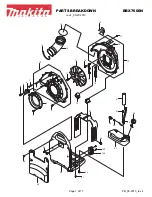
47
© 2006, Elektro-Automatik GmbH & Co. KG
Irrtümer und Änderungen vorbehalten
EN
Date: 06-05-2014
Instruction Manual
PS 8000 E 3U Series
Operating the device
8. Device setup
The device setup is intended to adjust certain operation para-
meters. It can only be accessed while the output is off. Push
both pushbuttons of the rotary knobs (also see section 6.3)
simultaneously for longer than 2s. Leaving the setup and sto-
rage of the settings is done the same way. Three elementary
settings are always available, see below. Other settings are only
available if a digital interface card is equipped.
Elementary settings
:
Parameter
:
AutoPwrOn
Default:
on
Settings:
on, off
Meaning: „
on
“ --> device restores the last output state and set
values of last time the device was switched off or a blackout
occured. The purpose is to make the unit automatically continue
operation after a blackout.
„
off
“ --> the output is switched on and the set values of U, UVL
and I are set to 0%, P to 100% and OVP to 110%, everytime
the unit is powered.
Parameter
:
AI range
Default:
0-10
Settings:
0-5, 0-10
Meaning: selects the control voltage range to use with the
analogue interface. Further details in section 10.
Parameter
:
Contrast
Default:
70
Settings:
50...100
Adjusts the contrast of the LCD display.
For
all
interface cards this setting applies:
Parameter
:
Device node
Default:
1
Settings:
1...30
Meaning: Selects the device‘s address (i.e. device node, term
taken from the CAN terminology). When using the device on a
bus system (CAN or GPIB), every device must have a unique
address!
Following settings only with
CAN interface IF-C1:
Parameter
:
Baud
Default:
100k
Settings:
10k,
25k,
50k,
100k,
125k,
250k,
500k,
1M
Meaning: Selects the CAN transmission baud rate.
Parameter
:
Base ID
Default:
0x000
Settings:
0x000...0x7FC (0...2044)
Meaning: Defines the base ID (BAID) for the CAN ID system with
three IDs (Vector compatible, dbc files). Three IDs are reserved
for a device, based upon the adjusted base ID. Thus this values
is only adjustable in steps of four. Display can be switched from
decimal to hexadecimal by pushing any of the rotary knobs.
Only available, if
ID Sys
=
Vector
has been selected. See
below at parameter
ID Sys
.
Parameter
:
Broad ID
Default:
0x7FF
Settings:
0x000...0x7FF (0...2047)
Meaning: Adjusts the broadcast ID (BCID) for the CAN ID sy
-
stem with three IDs (Vector compatible, dbc files). This extra
ID is a fourth ID for the device which can be used for broadcast
messages to multiple units on a bus. Purpose if this ID is to
adjust it to the same value on all units that are targeted to be
controlled simultaneously by set values or device conditions.
Display can be switched from decimal to hexadecimal by pus-
hing any of the rotary knobs.
Only available, if
ID Sys
=
Vector
has been selected. See
below at parameter
ID Sys
.
Parameter
:
RID
Default:
0
Settings:
0...31
Meaning: Selects the relocatable identifier segment (RID). Refer
to CAN terminology or instruction manual of the IF-C1 CAN
interface card for further information.
Parameter
:
Bus term
Default:
yes
Settings:
yes, no
Meaning: activates/deactives the bus termination resistor of
the CAN interface card. This is required if the device is at the
end of the bus.
Parameter
:
ID Sys
Default:
Vector
Settings:
Vector, normal
Meaning: Selects the CAN ID systems (IDSY). With „
Normal
“,
the former, old CAN ID system with two CAN IDs per unit is used,
where the IDs are built from „
Device node
“ (see above) and
„
RID
“ (see above) . Also see the external user manual for the in
-
terface cards regarding the calculation scheme of the CAN IDs.
The other ID system, selected with „
Vector
“, uses three CAN
IDs per unit and it thus enables the use of so-called DBC files
to implement the device into Vector company software. By
selecting this ID system, two ID related settings (see above)
become active, where the user adjusts a base ID that defines
the three CAN IDs, plus a broadcast ID (if used).
Following settings only with
RS232 interface IF-R1
:
Parameter
:
Baud
Default:
57600
Settings:
9600, 19200, 38400, 57600
Meaning: Selects the serial transmission baudrate (in baud).
Further parameters for the RS232 are not configurable, but
defined as follows:
Parity = odd
Stop bits = 1
Data bits = 8
and have to be set to the same co nfiguration at the PC.
Following settings only with
Profibus interface IF-PB1
:
Parameter
:
Profibus
Default:
1
Settings:
1-125
Meaning: Defines the Profibus address of the device. This
address is used apart from the device node to implement and
access the unit on a field bus system.






































